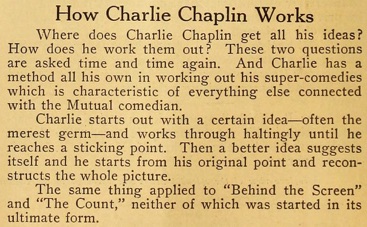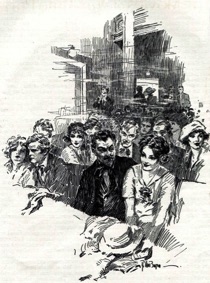Easy Street Clippings 1/81
Motion Picture News, New York, September 16. 1916.
FOOD FOR THE FIGHTERS – Subterranean bakeries
on the Eastern front supply warm bread at least once a day.
(...) Photo, New York Tribune, Oct. 29, 1916, detail
& Charging Under Hand Grenade Fire – An actual photograph
of trench war in the Somme, snapped at the instant
of the explosion of a German hand grenade at the feet of the
onrushing French detachment. The officer, who appears
to have been wounded, was in reality unhurt; but unmistakably
he was startled.
(...) American Press Association Photo, New York Tribune,
Oct. 29, 1916, detail
& Soldier Cops Parade – Uniformed and equipped as infantry,
two regiments of policemen march down Fifth Ave.
(...) Underwood & Underwood Photo,
New York Tribune, Oct. 29, 1916
& Photo. The air is blue with smoke; each man has his sweetheart
by his side and makes love to her openly
and unblushingly throughout the performances.
(...), The Movies of War-Time Paris, Photoplay, June 1916
& How Charlie Chaplin Works
Where does Charlie Chaplin get all his ideas? How does
he work them out? These two questions are asked time
and time again. And Charlie has a method all his own in working
out his super-comedies which is characteristic of everything
else connected with the Mutual comedian.
Charlie starts out with a certain idea – often the merest
germ – and works through haltingly until he reaches
a sticking point. Then a better idea suggests itself and he starts
from his original point and reconstructs the whole
picture.
The same thing applied to Behind the Screen and The Count, neither of which was started in its ultimate form.
(...) Motography, May 5, 1917
„Two large settings have been built“
Editorial content. „IN AND OUT OF WEST COAST STUDIOS“ (...)
„Easy Street will be the title of the Chaplin-Mutual
subject which will follow The Count in release. It is now being
made at the studio, and for it two large settings have
been built.“
Easy Street follows not The Count, but The Rink
in release.
Redaktioneller Inhalt
Alan Nevins & Henry Steele Commager, The Pocket History
of the United States, New York 1942: „In the presidential elections
of 1916 Wilson was successful, largely because he had ,kept
us out of war.‘“
He Kept Us out of War. That‘s his campaign slogan.
The fighting in Europe dominates the campaign. Woodrow Wilson campaigns for re-election on a pledge of continued neutrality
in the World War One
Election night is on November 7, 1916. The electoral vote
is one of the closest in American history – with 266 votes needed
to win, Wilson takes 30 states for 277 electoral votes, while
Hughes wins 18 states and 254 electoral votes.
After the sinking of seven U.S. merchant ships by submarines
and the publication of the Zimmerman telegram, Wilson
calls for war on Germany, which the U.S. Congress declares
on April 6, 1917.
Am 28. Juli 1914 hat der Erste Weltkrieg begonnen –
„the european war“ wird er oft in amerikanischen Zeitungen
vorerst noch genannt. Am 7. November 1916 gewinnt
US-Präsident Wilson die Wiederwahl. Sein Slogan –
He kept us out of war – ist erfolgreich. Am 6. April 1917 ruft
Wilson aber zum Krieg gegen Deutschland auf.






